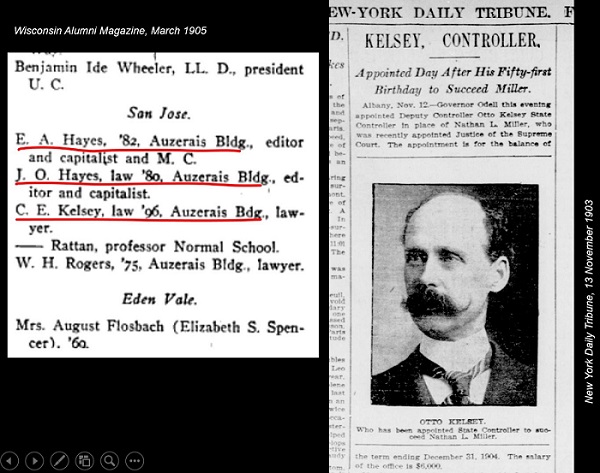Kelsey brought some attractive attributes to the Northern California Indian Association and its chiefly female and ecclesiastical leadership. He had firsthand experience with Native Americans, knowledge of the Indian Office, and a law degree. As a white man, his actions and movements were unrestricted. He also brought his rolodex.
Being a university graduate and professional man, Kelsey had opportunities to develop connections with powerful Republicans. Among his neighbors in the Auzerais Building, where he had his San Jose law office, were fellow University of Wisconsin alumni Everis A. Hayes and Jay O. Hayes. In a time when newspapers had a significant voice in current affairs, the Hayes brothers published the San Jose Daily Mercury Herald. Everis Hayes gained even greater prominence when, in 1905, he began the first of seven consecutive terms in the US House of Representatives. In 1906 Kelsey was quoted in their newspaper, stating that “he was materially aided in his efforts to secure the [$100,000] appropriation [for California Indians] by Congressman E. A. Hayes, who took a great deal of interest in the movement.”
Kelsey also had a connection to President Theodore Roosevelt. Kelsey’s older brother, Otto, was active in state politics in New York, which was Roosevelt’s home base, and both were Republicans. When Roosevelt was governor, Otto was a member of the state assembly. During Roosevelt’s presidency, Otto served as state comptroller and state superintendent of insurance. C. E. Kelsey possessed an undated letter from Otto to the president, introducing “C. E. Kelsey, whom I recommend to you with utmost confidence.”
President Roosevelt visited San Jose in May 1903 on his Great Loop tour, the grand cross-country excursion during which he famously camped in Yosemite with John Muir. The NCIA used his visit to launch its formal campaign by presenting Roosevelt with a memorial about the history and current status of the landless Indians of northern California. A cover letter signed by C. E. Kelsey introduced the memorial. It is not known whether Kelsey personally presented the document to Roosevelt, but it seems likely. Kelsey alone among NCIA leaders had the connection–and the letter of introduction–to facilitate exactly that.
